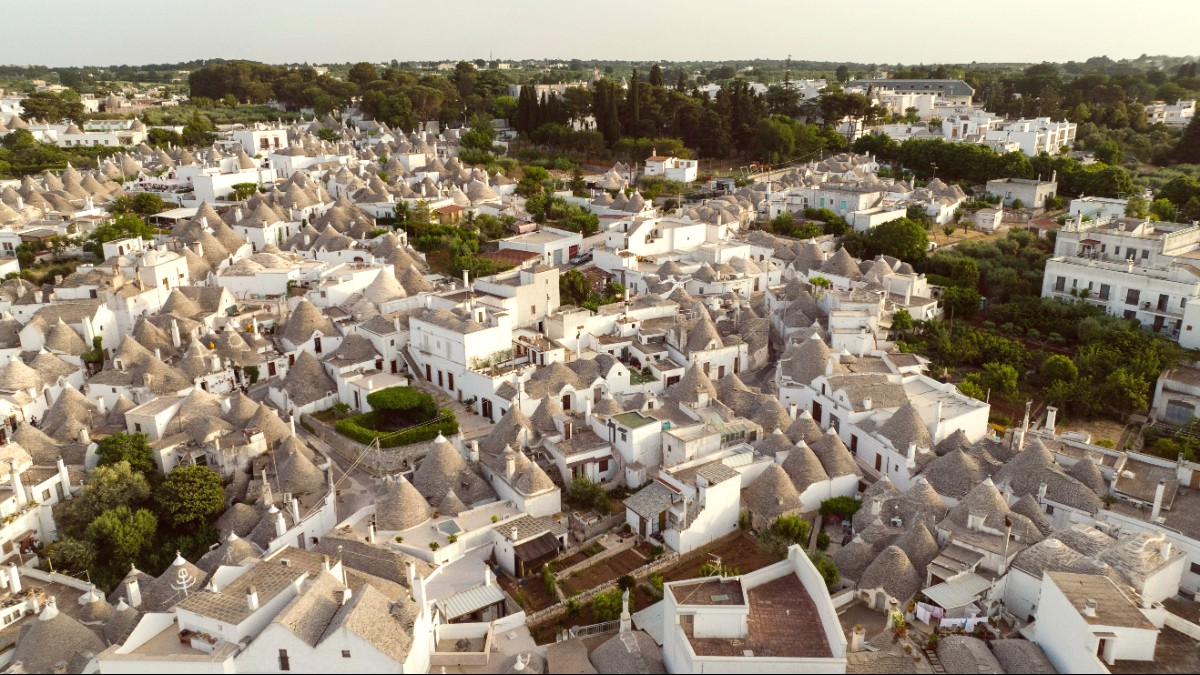
Puglia, Italy
Alberobello presents a living museum of architectural ingenuity and enduring culture. The town's narrow lanes and hidden courtyards await exploration, revealing the resilient spirit of its inhabitants. Visitors experience a bygone era, where the pace slows, and the simple beauty of stone and sky holds attention. History enthusiasts, photographers, or those seeking a peaceful escape find an experience unlike any other. The town’s charm extends beyond its famous buildings, with a warm local welcome and a genuine connection to its heritage.
Wander without a map. Explore the winding lanes of the trulli districts. Discover unexpected viewpoints and quieter corners.
This approach can reveal unique aspects of the town not found on typical tourist routes.
Alberobello lies in the heart of Puglia, Italy's "heel." The town resides in the province of Bari, on the southeastern side of the country. This location places it in the center of the Valle d'Itria, a valley known for its gentle rolling hills, ancient olive groves, and conical-roofed dry stone huts, the trulli. The Valle d'Itria is a geological depression; its landscape differs from Puglia's coastal plains. This distinct micro-environment fostered the trulli building style.
The town’s geographical coordinates are approximately 40.785° North latitude and 17.236° East longitude. It stands at about 428 meters (1,404 feet) above sea level. This elevation gives Alberobello a climate different from coastal areas, often with cooler evenings even in summer. It feels nestled within a specific landscape. The higher ground presents vantage points for surveying the surrounding countryside: vineyards, cherry orchards, and cultivated fields, all dotted with scattered trulli. This pastoral setting contrasts with the trulli districts.
Alberobello's position establishes it as a natural hub for exploring central Puglia.
It lies about 55 kilometers (34 miles) southeast of Bari, the regional capital and a major port city with an international airport. This distance makes Alberobello accessible for travelers flying into Bari.
Further south, Alberobello is about 70 kilometers (43 miles) northwest of Lecce, another Puglian city known for its Baroque architecture.
This central location within Puglia enables day trips to many other towns and coastal areas, making Alberobello a base for regional exploration.
The landscape around Alberobello is not flat. The soil is fertile, supporting agriculture.
Centuries-old olive trees dominate the landscape, their gnarled trunks and silvery leaves ever-present. Vineyards also spread across the hills, contributing to Puglia's wine-producing reputation. Distinctive architecture and agricultural surroundings create a harmonious blend of culture and nature.
Geography shapes Alberobello’s microclimate. Its inland, elevated position lessens intense humidity and heat common in Puglia’s coastal areas during peak summer months, though summers remain hot. Gentle breezes through the Valle d'Itria temper the heat.
The area's limestone geological composition was a factor in trullo construction; stone was readily available from farming and building excavations. This direct connection between land and traditional architecture is a hallmark of Alberobello's identity.
Rent a car to explore the Valle d'Itria. Stop at small villages, discover hidden masserie (fortified farmhouses), and enjoy scenic drives through the countryside at your own pace.
Alberobello's unique trulli constructions date back to the 14th century. Then, the Acquaviva counts of Conversano controlled the region. These counts imposed a system preventing new settlements from using mortar, a method to avoid taxes on permanent dwellings. Building with dry stone, without bonding material, allowed easy dismantling upon royal authority inspection. This practice helped the counts and their subjects avoid taxes on new settlements and maintain temporary housing. This architectural solution became Alberobello's defining characteristic.
Building without mortar resulted in trulli as In situ structures, rising from abundant limestone rocks. Each trullo was a balanced stone stack, topped with a conical roof that shed water efficiently. This construction also created cool interiors in summer and warmer spaces in winter, a natural climate control. Quick demolition and rebuilding kept the count's feudal subjects in a precarious state, technically never forming a permanent "village" that triggered royal taxation. This historical context displays the local population's resourcefulness and ingenuity in adapting to feudal rules.
A turning point for Alberobello happened in 1797. That year, Ferdinand IV of Bourbon, King of Naples, intervened. He granted Alberobello royal town status. This act was an achievement for the inhabitants; it liberated them from the Acquaviva counts' feudal servitude. The new royal status included the right to build permanent structures with mortar.
Alberobello's historical path led to its designation as an UNESCO World Heritage Site in 1996. This recognition came for the town's standing as an "outstanding example of a vernacular architectural style" and its depiction of a traditional human settlement vulnerable in the modern world.
The town splits into two main trulli districts: Rione Monti and Aia Piccola. Rione Monti is the larger and more commercialized, with over 1,000 trulli. Aia Piccola is smaller, with about 400 trulli, remaining largely residential.
UNESCO observed the "integrity and authenticity" of the trulli, noting their value as a testament to human resourcefulness and adaptation to environmental and historical constraints.
Alberobello holds a clear and memorable identity, discernible through a few distinct features. Its prominent Architectural style is undeniably the presence of over 1,500 Trulli.
These dry-stone, conical-roofed structures render the town a visual wonder. The Trullo Sovrano, Alberobello's sole two-story trullo, today operates as a museum.
The Church of Saint Anthony of Padua, from 1927, designed in the characteristic trullo shape, solidifies the town's architectural identity.
A small, charming town with unmatched architectural identity, supported by tourism and agriculture.
Every element, from conical roofs to local olive oil, narrates adaptation, endurance, and unique beauty.
The commitment to maintaining trulli historical integrity, while embracing modern visitors, appears in the careful balance throughout the town.